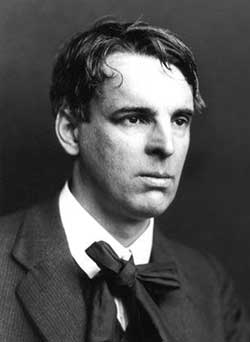"The Cat and the Moon" was included in one of W. B. Yeats' most famous collections of poetry, "The Wild Swans at Coole," published in 1919.
The cat in the poem (Minnaloushe) allegedly belonged to Maude Gonne, who was the object of a lifelong obsession for Yeats. The cat character also causes this poem to be often categorized as “feline poetry,” which is rather amusing and seems to oppose much of Yeats’ other, more academic poetry.
W. B. Yeats calls attention to his own personal fascination with the cycles of the moon, as seen in the lines, "The sacred moon overhead / Has taken a new phase." This fixation with the moon’s cyclic nature is a recurring theme throughout much of Yeats’ poetry.
Yeats also places great emphasis on the cat-moon relationship. He comments that Minnaloushe "lifts to the changing moon / His changing eyes." This seems to imply that the similarities between the two entities focus largely on their cyclic, changing phases from "round to crescent." However, the wandering nature of the cat leads to his "troubled...animal blood," whereas the moon functions as "the pure cold light in the sky," unaffected by the things that trouble the mortal cat.
Unlike many of Yeats' other poems, "The Cat and the Moon" seems highly playful, indicating that the "important and wise" cat could possibly teach the moon "a new dance turn." This contrasts starkly to the intense seriousness of Yeats’ poem, “Leda and the Swan” in which the man-animal relationship is much more imposing and domineering on the part of the animal. There is no subtle jesting or making light of the subject, as in “The Cat and the Moon.” The feline protagonist is depicted as good-natured, “lifting his delicate feet” as he runs through the grass, as opposed to the Swan who rapes Leda and forces her to surrender to his will.
The cat in the poem (Minnaloushe) allegedly belonged to Maude Gonne, who was the object of a lifelong obsession for Yeats. The cat character also causes this poem to be often categorized as “feline poetry,” which is rather amusing and seems to oppose much of Yeats’ other, more academic poetry.
W. B. Yeats calls attention to his own personal fascination with the cycles of the moon, as seen in the lines, "The sacred moon overhead / Has taken a new phase." This fixation with the moon’s cyclic nature is a recurring theme throughout much of Yeats’ poetry.
Yeats also places great emphasis on the cat-moon relationship. He comments that Minnaloushe "lifts to the changing moon / His changing eyes." This seems to imply that the similarities between the two entities focus largely on their cyclic, changing phases from "round to crescent." However, the wandering nature of the cat leads to his "troubled...animal blood," whereas the moon functions as "the pure cold light in the sky," unaffected by the things that trouble the mortal cat.
Unlike many of Yeats' other poems, "The Cat and the Moon" seems highly playful, indicating that the "important and wise" cat could possibly teach the moon "a new dance turn." This contrasts starkly to the intense seriousness of Yeats’ poem, “Leda and the Swan” in which the man-animal relationship is much more imposing and domineering on the part of the animal. There is no subtle jesting or making light of the subject, as in “The Cat and the Moon.” The feline protagonist is depicted as good-natured, “lifting his delicate feet” as he runs through the grass, as opposed to the Swan who rapes Leda and forces her to surrender to his will.

